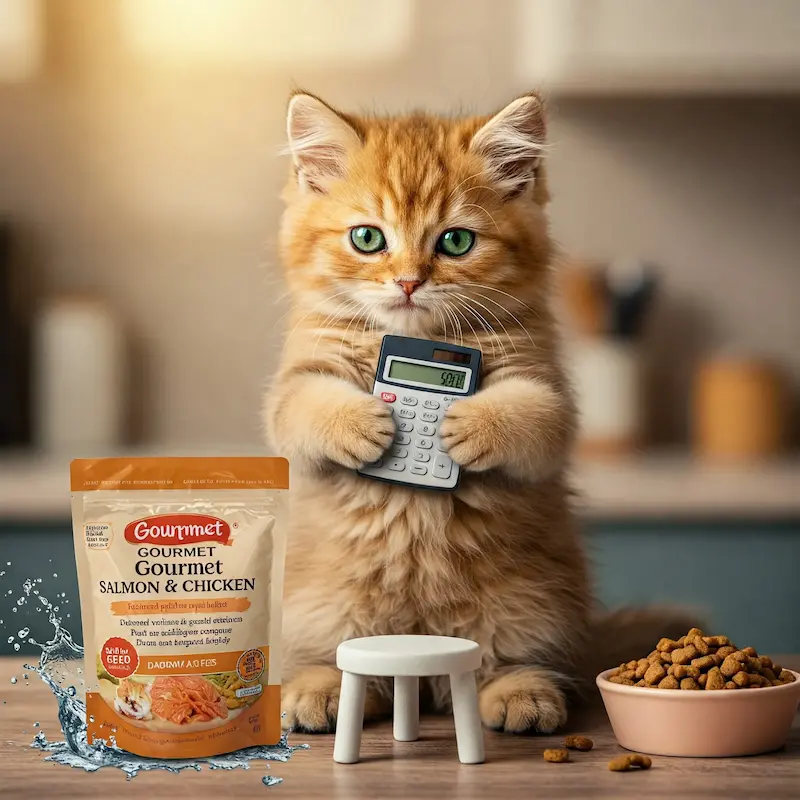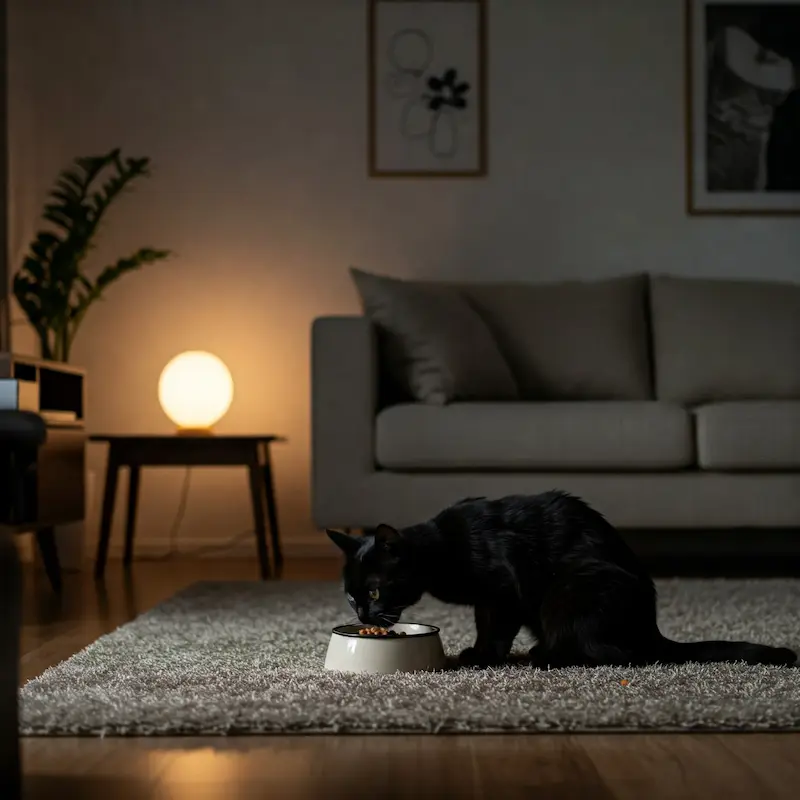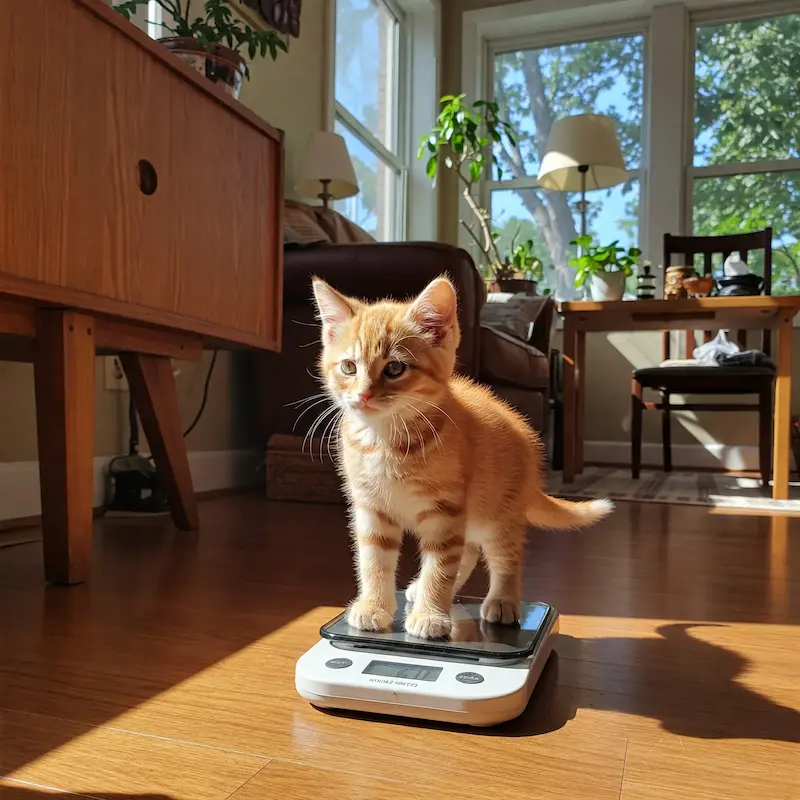Cat Food Calculator: How to Feed Your Cat the Right Way Every Day
Feeding your cat the right amount of food is crucial for maintaining their well-being, but figuring out the perfect portion can be tricky. A cat food calculator is a simple yet effective tool that takes the guesswork out of meal planning. By considering factors like weight, activity level, and diet type, these calculators ensure your cat gets the nutrition they need.
Сat Сalculator Food
Estimated Initial Daily food amount
Times a Day
If you're unsure about your cat's daily calorie needs, tools like the Cat Calorie Calculator can help you determine the right intake. Additionally, the Cat Food Carb Calculator is great for understanding the carbohydrate content in their meals. These resources make managing your cat's diet easier and more precise, promoting a healthy and happy life for your feline friend.
In This Article
Understanding the Basics of Cat Feeding Calculations
Feeding your cat effectively starts with knowing how to calculate their nutritional needs. Every cat is unique, and factors like weight, activity level, and food type influence how much they should eat. By breaking this down into easy-to-manage steps, you can take the guesswork out of mealtime and ensure your feline friend is happy and healthy.

The Role of Calories in a Cat's Diet
Calories are the building blocks of your cat’s daily energy needs. Understanding how many calories your cat requires is a key step in maintaining their health and preventing both underfeeding and overfeeding. Using tools like the Cat Calorie Calculator simplifies this process, offering a reliable guideline based on your cat’s age, weight, and activity level.
For instance, a young, energetic cat will have higher calorie demands compared to a senior feline who spends most of the day napping. Here are some notable factors affecting calorie needs:
- Age: Kittens and younger cats generally need more calories to support growth and activity.
- Weight: Overweight cats require calorie adjustments to help shed extra pounds, while underweight cats may need higher portions.
- Activity Levels: Cats who roam, jump, and play need more energy than those who lead a sedentary lifestyle.
Adjusting your cat's diet based on these variables ensures they get the right amount of energy while avoiding unnecessary weight gain or deficiencies.
Portion Sizes for Different Food Types
The type of food you feed your cat—wet, dry, or a combination of both—also determines portion sizes. Each comes with its own nutritional profile and feeding guidelines. It's important to measure portions attentively, particularly if you're considering mixed feeding strategies.
- Wet Food: Wet food is typically lower in calories by weight, which means you'll need to serve a larger portion compared to dry food. It's also an excellent way to help your cat stay hydrated.
- Dry Food: Dry kibble has a higher calorie density and is easy to store and measure. However, balance is crucial to avoid overfeeding.
- Mixed Diets: Many pet owners blend wet and dry food to offer variety and improved hydration while keeping portion sizes balanced. This requires careful calculation to ensure your cat isn’t overfed.
If you’re concerned about carbohydrate content in cat food, the Cat Food Carb Calculator can help. It analyzes food labels to provide a better understanding of how carbs contribute to your cat’s diet, helping you make informed decisions about portioning.
Common Feeding Mistakes to Avoid
- Overfeeding: Cats have smaller calorie needs than you might think. Regularly measuring portions and sticking to calculated calorie requirements prevents obesity.
- Improper Balancing of Wet and Dry Food: Feeding a mix of wet and dry food without considering calorie content can lead to overfeeding. Use feeding charts and calculators for accuracy.
- Ignoring Activity Levels: Sedentary cats won’t burn calories at the same rate as active ones. Tailor meals to reflect their lifestyle.
- Not Reading Food Labels: Food labels have key information about nutritional content. Use tools like a carb calculator to understand what’s in your cat’s meals.
- Leaving Food Out: Free-feeding (leaving food available all day) can lead to overeating, especially with calorie-dense kibble.
By staying mindful of these pitfalls and adjusting your approach as needed, you can help your cat avoid health issues and maintain a well-balanced diet.
Step-by-Step Guide to Using a Cat Food Calculator

Understanding how to use a cat food calculator can make feeding your feline both accurate and stress-free. By entering specific details about your cat, you gain valuable insight into portion sizes, calorie needs, and dietary balance. Let’s look at how to make the most out of such tools, broken down into easy-to-follow steps.
Gathering Essential Data
- Weight: Whether your cat is underweight, overweight, or at an ideal weight influences their daily calorie needs. Accurate weighing ensures correct calculations.
- Age: Kittens, adult cats, and senior cats all have unique nutritional requirements. Younger cats need more calories for growth, while older cats benefit from moderate, balanced meals.
- Activity Level: An active cat that loves to jump and explore will burn more calories, while a sedentary cat requires fewer. Keep track of your cat’s behavior to ensure precise calculations.
- Dietary Preferences: Knowing whether your cat prefers wet food, dry food, or a mix is crucial since each type has different calorie concentrations and nutritional benefits.
- Special Considerations: If your cat has a medical condition or specific dietary requirements, you’ll need to adjust their diet or discuss results with a vet.
Gathering this data might seem like a small step, but it lays the foundation for a personalized feeding strategy that works best for your feline. Resources like the Cat Food Carb Calculator can help you understand additional details, such as the carbohydrate content of your cat’s meals.
Analyzing Results
Once you’ve entered the required information into a cat food calculator, the results will typically display essential data about your cat’s diet. Here’s how to interpret the outputs:
- Daily Calorie Needs: This tells you how many calories your cat needs each day. It serves as a benchmark for portioning their food correctly, regardless of the type of food you select.
-
Portion Sizes for Food Types:
- Wet food portions are usually larger in weight compared to calorie-dense dry food.
- For mixed feeding, calculate how wet and dry portions correspond to your cat’s calorie requirements.
- Hydration Insight: Wet food contributes to hydration, while dry food does not. If your cat eats primarily dry food, balance their hydration by offering plenty of water or exploring the Cat Water Intake Calculator.
By breaking down these results and combining them with your observations of your cat’s behavior and health, you gain a clear perspective on how to tailor their diet effectively.
Adjusting Portions Over Time
- Monitor Their Weight: Weigh your cat every few weeks and compare their weight gain or loss to the recommended range. This helps ensure consistency in achieving or maintaining a healthy size.
- Observe Eating Behavior: Is your cat finishing every meal or leaving food behind? Adjust portions slightly to match their appetite without overfeeding.
- Use Calculators Regularly: Periodic use of tools like the Cat Calorie Calculator or Cat Food Carb Calculator ensures you’re staying updated on your pet’s ideal feeding plan.
- Pay Attention to Health Signs: Changes in coat quality, energy levels, or bathroom habits can indicate dietary imbalances. A calculator helps fine-tune portions to address these issues.
Adjustments don’t have to be daunting. Think of it as tweaking a recipe—small changes can yield big improvements in your cat’s overall well-being. Embracing regular calculations ensures long-term health and happiness for your feline friend.
Special Feeding Considerations for Kittens, Seniors, and Cats with Health Issues

Kitten Feeding: Calorie and Portion Size Needs
- Increased Calorie Needs: Kittens need nearly double the calories per pound than adults.
- Frequent Meals: Feed 3–4 small meals per day.
- Proper Balance: Prioritize high-protein, nutrient-dense food.
Need recipe help? Try the Recipe List Tool for kitten-appropriate options.
Senior Cats and Special Diets
- Portion Control: Seniors need fewer calories but still quality protein.
- Joint & Kidney Support: Look for glucosamine and low-phosphorus formulas.
- Weight Monitoring: Unusual gain or loss could mean health issues.
Use the Cat Calorie Calculator to keep your senior cat on track.
Managing Diets for Overweight or Diabetic Cats
- Strict Portion Control: Use measuring tools for accuracy.
- Low-Carb Diets: Stick to high-protein, low-carb food.
- Regular Feeding Schedule: Helps stabilize blood sugar levels.
Use the Cat Food Carb Calculator to review food labels and optimize your cat’s diet.
Conclusion
Using a cat food calculator takes the mystery out of feeding your feline friend, ensuring their diet is both balanced and tailored to their unique needs. From determining daily calorie requirements to portioning wet or dry food correctly, these tools help you make informed decisions for your cat's health and happiness.
By incorporating resources like the Cat Food Carb Calculator and the Cat Calorie Calculator, you can provide precise nutrition effortlessly. Start today and take the first step toward better mealtime planning, supporting your cat’s well-being for years to come.
Cat Food Calculator FAQs: Feeding Your Cat the Right Way
- How does a cat food calculator work?
- A cat food calculator estimates your cat's daily calorie needs based on factors like age, weight, activity level, and health. It helps you determine the correct portion sizes to support optimal health.
- Why is portion control important for cats?
- Overfeeding can lead to obesity, while underfeeding can cause malnutrition. Portion control ensures your cat gets the right balance of nutrients and calories without overindulging or missing essential nourishment.
- What factors affect how much my cat should eat?
- Key factors include your cat's age, weight, activity level, breed, metabolism, and whether they’re spayed or neutered. Health issues like diabetes or thyroid conditions can also affect dietary needs.
- How often should I feed my cat?
- Most adult cats do well with two meals a day—morning and evening. Kittens often need three to four smaller meals daily. Talk to your vet for advice based on your cat’s specific needs.
- Can I use a calculator for both wet and dry food?
- Yes, but you’ll need to calculate wet and dry food portions separately since they have different calorie densities. Ensure the total meets your cat’s daily calorie requirements.
- Should I measure cat food by weight or volume?
- Measuring by weight is more accurate because kibble shapes and sizes vary. Use a kitchen scale to weigh portions rather than relying on a measuring cup.
- What should I do if my cat is overweight?
- Switch to a calorie-controlled diet and consult your vet to create a weight loss plan. Use a calculator to adjust portions gradually and focus on healthy, vet-approved foods.
- Are calorie needs different for indoor vs. outdoor cats?
- Yes. Indoor cats are usually less active and need fewer calories than outdoor cats, who burn more energy exploring and hunting. Adjust portions based on their activity level.
- Can my kitten use the same food calculator as an adult cat?
- Most calculators have a setting for kittens, which accounts for their rapid growth and higher calorie requirements. Kittens need more frequent meals and nutrient-dense food.
- How do I transition to using a cat food calculator?
- Start gradually. Measure your cat’s current portions, check calorie density on the food label, and use the calculator to determine the correct amount. Adjust over 7–10 days to avoid digestive upset.
- Do I need to factor in treats?
- Yes. Treats shouldn’t exceed 10% of your cat’s daily calorie intake. Subtract the calorie amount from their main food to avoid overfeeding.
- What if my cat refuses to eat the calculated amount?
- Some cats may need an adjustment period. Ensure the food is fresh and served at room temperature. If the issue continues, consult your vet to rule out health problems.
- Are homemade diets included in food calculators?
- Some calculators allow custom inputs for homemade diets. You’ll need to know the caloric content of each ingredient. Work with a vet or nutritionist to ensure the diet is balanced.
- How do I calculate food for a sick or senior cat?
- Senior or sick cats often have unique dietary needs. Use a calculator designed for special conditions and consult your vet to tailor their diet properly.
- When should I update my cat’s feeding plan?
- Reevaluate your cat’s needs whenever their weight, activity level, or health status changes. Regular vet check-ups can help you stay on track.
- Does a food calculator replace vet advice?
- No, it’s a helpful tool but not a substitute for professional guidance. Always consult your vet for specific dietary advice tailored to your cat’s health.
CatsLib.com relies on trusted, high-quality sources, including peer-reviewed research, to back the information in its articles. We regularly review and update our content to ensure it remains accurate and reliable.
- Case, L. P., Carey, D. P., Hirakawa, D. A., & Daristotle, L. (2011). The Cat: Its Behavior, Nutrition & Health.
- Hand, M. S., Thatcher, C. D., Remillard, R. L., Roudebush, P., & Novotny, B. J. (2010). Small Animal Clinical Nutrition (5th ed.).
- Eldredge, D. (2008). Cat Owner's Home Veterinary Handbook.
- National Research Council. (2006). Nutrient Requirements of Dogs and Cats.
- Cat Food – Wikipedia
- PetMD: How Many Calories Does a Cat Need?
- VCA Hospitals: Feeding Your Cat
- ASPCA: Cat Nutrition Tips
Recent Articles

Why Are Siamese Cats Cross Eyed? Genetics, Health, and Care Guide

Do Ragdoll Cats Shed a Lot? Seasonal Tips to Manage Fur and Keep Your Home Clean

10 Medical Reasons Your Cat Is Walking in Circles – Signs You Should Never Ignore

Why Does Your Cat Scratch Around Its Food Bowl? Top Reasons and Simple Solutions
